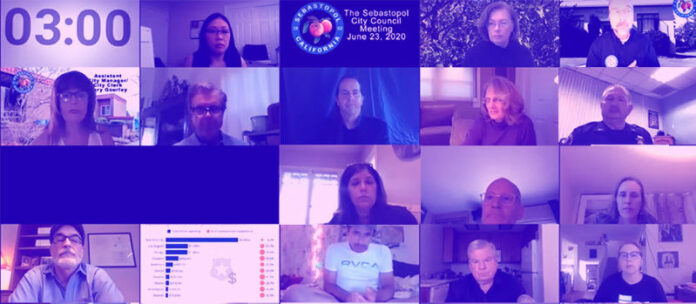The next public meeting on police policy and race is Tuesday, June 30 at 6 p.m.
This is Part 2 of a two-part article based on the first meeting. Because the meeting was held on Zoom and the chat function had been disabled, there was no way to contact speakers to check on the spelling of their names. A list of speakers obtained from city also mostly listed first names only so this article will, for the most part, do the same.
On June 23, the city of Sebastopol held the first of two meetings on the topic of police use of force. The first third of the evening was taken up by introductions from Mayor Patrick Slayter and Vice Mayor Una Glass and presentations from the acting chief of police Greg Devore and attorney Jerry Threet, former director of Independent Office of Law Enforcement Review and Outreach (IOLERO).
The majority of the evening, however, was made up of public comment. Of the 99 people who attended the Zoom meeting, 20 people spoke during public comment, and most of the speakers thanked the city for holding the meeting as a way of kicking off this important public conversation.
Public comment on oversight, budgets and data
Threet spent a significant portion of his presentation discussing the need for police oversight, and many speakers picked up on this theme.
James Jacob, a local teacher, noted that teachers get evaluated regularly and that he thought this would be a good idea for police officers as well.
“We need to have an independent audit to get a general idea about how police funds are spent, and how police time is spent, and how Sebastopol police policies compare to the best practices elsewhere in the United States,” Jacob said. “We should also have an audit with questions about how often officers are disciplined.”
Defense attorney Omar Figueroa said, “A very important reminder about having independent civilian oversight: We as a country don’t allow the military to run the country — they have civilian oversight. How do we allow the police to not have civilian oversight? So, we ask the city council: this is something you can do right now without having to conduct any lengthy expensive studies.”
Many speakers also noted that police services make up a large percentage — 45% — of the city of Sebastopol’s budget.
However, as one speaker pointed out, budgets are about more than money.
“One of the things that has come up is making the Sebastopol Police Department represent our values and that’s a good idea, but we also need to make the budget represent our values,” said Jasmine. “Budgets are, among other things, a statement of priorities. So, if you have a budget where the largest budget item is the police, then what you’re really saying is that our biggest priority is the police; we’re going to be tough on crime and we’re going to have men with guns showing up on anytime there’s trouble.”
She questioned whether that stance was really in line with Sebastopol’s values.
Analy High School students Amy and Rachel Cohen agreed.
“We fully support defunding the police, but we know this is a change likely too abrupt for the community right now. Instead, we could begin by redirecting some of the funding that goes to the police department to our schools, infrastructure, housing and other public services, like services for fire prevention and recovery.”
Figueroa took issue with the question of “defunding the police,” saying “Nobody here is calling to defund the police, that’s not what we want. We want to reimagine our police resources.”
Most speakers bemoaned the relative lack of data on which to base any decision making.
Claire McDonald asked, “It’s all hearsay right now. We literally can’t say if our police are doing a good job right now, other than the fact that there’s 99 people attending a meeting, asking for reforms and changes. And so I’m wondering, how can we collect data to understand really what is going on?
Mayor Slayter pointed out there was a detailed breakdown of police expenses in the Sebastopol City Budget, which is available on the city’s website, but Vice Mayor Glass noted that the largest item in the police budget — salaries — is a bit of a black box.
“We know we spent x-amount of money on personnel, but how is that time being spent? … I think that that is actually a really important question for us to be figuring out, and I don’t think we really have all of that information. At least it’s not in the budget.”
On the issue of race
The issue of race was touched on briefly by a few speakers, who spoke of their own internalized racism and their attempt to be better allies for people of color. Analy student Dezi Rae Kai, the organizer of a large Black Lives Matter march Sebastopol, read a statement about her experience growing up in Sebastopol as a person color.
“Growing up as a person of color in America, from a very young age we’re passed on this tremendous fear … a fear of law enforcement is passed down from generation to generation and is fed by the continuous occurrence of brutality and oppression that has occurred in this country for far too long. This takes a huge toll mentally on people of color. So when there are interactions with people of color and law enforcement there’s usually strong reactions coming from both sides.”
Kai mentioned that she was afraid of being pulled over by the police because “I worry that my nervousness and fright might be mistaken for erratic behavior simply because the way people react to the color of my skin.”
Questions from the public
Kai and several other speakers had questions for the police chief and the mayor, and the last part of the meeting was devoted to a question and answer session:
What data is available to the public?
Devore: That’s kind of a broad question, but let’s start with traffic stop data. What is easily obtainable data through our system would be how many traffic stops, time of the day, whether somebody was cited or not and if they were cited for what violation. That would be something that would be fairly easy to come up with. As far as other incidents we do put out a press report that goes out every week that covers all the different calls that we handle. It refers to what type of call they were and the general area. And you can get a lot of data from the police department through a public records request.
Slayter: So I suppose the nuts and bolts answer is if you have a question about some data or statistics, contact either the Sebastopol Police Department or city clerk, and we will accommodate that request to the very best of the city’s ability within the bounds of the law.
Were Sebastopol Police officers in Santa Rosa in support of the Santa Rosa Police Department over the last couple of weeks?
Devore: Yes, we did send them off first to Santa Rosa. They put out a request to every agency in the county and all agencies responded.
Slayter: It’s called mutual aid, and it’s both fire and police. If Sebastopol had an incident and we needed assistance with enforcement or fire services, other agencies would come and help us in our time of need. And I’m not going to place a value on whether or not that was a time of need, that’s for people at a higher pay grade than I have to determine.
How much racial bias training, how much de-escalation training, and crisis stabilization training do officers get?
Slayter: I really appreciate all the comments about that because that that is certainly something that I’m interested in learning more about and looking at in a much greater way.
Devore: In terms of training, I think that’s something that we’ll probably have to discuss at our next meeting. We do go through that type of training but to answer exactly how much I would have to go through everybody’s record and see exactly which classes they’ve gone through. I do not have that data in front of me.
When they’re talking about crisis stabilization, I think they’re talking about the mobile support team, which just started coming to Sebastopol area about a year ago; before that it was mainly in the Santa Rosa area and we did not have access to it. Trust me, my officers kept calling; we wanted it here. Now that it is here it is something that we do use. If we are dealing with somebody with mental health issues, if they are available, we call them, but they are only available for limited hours during the day.
Is it possible to research specific incidences or specific actions of individual officers? Is that a possibility for a resident to do?
Devore: It’s kind of a difficult question to answer. It would depend upon what information. What I would suggest to the public is if they have a question, they could submit the public records request. There are things that are confidential or are not releasable. So it would depend exactly what type of information they’re looking for.
What’s the policy surrounding release of body cam footage?
Devore: Body cam video at this time in California is considered evidence and in most cases is not released. But as most people know within the last year or so there was a Senate bill that does require us to release video under certain conditions in certain instances — use of lethal force and things of that nature.
How does the police department communicate with the public, particularly in terms of the use of Nixle?
Slayter: I think it’s more of a city-wide question. I surely understand what the member of the public was getting at about how our reports written and how are they vetted for neutrality. I wonder if our city manager/city attorney would like to take that one on.
City Attorney/City Manager Larry McLaughlin: We have an outreach coordinator that does coordinate most of the messages that go out. However, law enforcement is responsible for their own Nixles, particularly matters that need urgent public attention. Not all of those go through our outreach coordinator. Some of them are brought by the police department directly.
How do officers learn about policy changes within the department?
Devore: Well, we’ll take for instance, the last change of policy, which was removing the carotid restraint. So as I was saying we use a system that’s called Lexipol most agencies throughout the state use it. When I do a change to a policy, update a policy, it sends an email to each officer, telling them that they need to link into Lexipol, they actually have to go in; they have to read the policy to see what changes are there and actually acknowledge that they have read it. I also always do a follow up. I sent out an email in regard to the carotid restraint telling them exactly what the change was and that it was no longer allowed.
Questions from the council
Councilmember Michael Carnacchi: I have a question with regard to the militarization of the police. Does the Sebastopol Police Department have tear gas?
Devore: No, sir, we do not.
Carnacchi: Do you have rubber bullets?
Devore: No, sir, we do not.
Carnacchi: Do you use flash grenades?
Devore: No, sir.
Carnacchi: And in terms of militarization, we don’t take any of the free equipment from the federal government. Is that correct?
Devore: We do not take that. Years ago, most departments did, but we stopped doing it many, many years ago.
Councilmember Glass: what happens when an officer has a complaint lodged against them?
If an officer was involved in something that we consider to be pretty outrageous — something like extreme use of force — they’d would first be put on administrative leave to make sure that he or she is off the street, so that that incident will not happen again. Then there would be a full investigation into the incident, and then it would depend upon the findings of the investigation as to what would happen. There are multiple levels of punishment that could possibly happen. Or, it could turn out that we determine the officer didn’t violate any rules.
The next public meeting on police policy and race is Tuesday, June 30 at 6 p.m. See the city website for more details. https://ci.sebastopol.ca.us/Meeting-Event/City-Council/2020/City-Council-Special-Meeting-of-June-30,-2020









